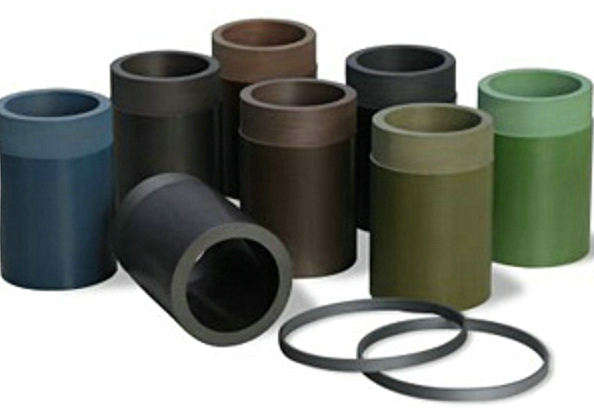
Practically any material that can withstand the sintering temperature of PTFE can be used as filler. Characteristics such as particle shape and size, and the chemical composition of the filler greatly affect the properties of the compound. All fillers used in PTFE compounds have been carefully selected and were in several cases specially developed to give the best balance of properties. The following paragraphs discuss the main features of the most commonly used fillers.
Glass fibre is the most widely used filler. It improves the creep resistance of PTFE, both at low and high temperature. It is chemically stable (except to strong alkalis and hydrofluoric acid - HF).It has little effect on the electrical properties of PTFE, and improves its wear and friction behavior. A not uncommon problem with glass-filled PTFE is discoloration of the finished parts, in particular on the inside of large billets. The glass used in PTFE compounds has been treated by a proprietary process to reduce this discoloration.
| GLASS | |
|---|---|
| Type | |
| Milled fibres nominal | E-glass |
| diameter | 13 µm |
| Nominal length | 0.8 mm |
| Aspect ratio | min. 10 |
| Density | 2.5 |
Amorphous carbon is one of the most inert fillers, except in oxidizing environments where glass performs better. Carbon adds to the creep resistance, increases the hardness and raises the thermal conductivity of PTFE. Carbon filled compounds have excellent wear properties, in particular when combined with graphite. The combination of the above properties makes carbon/graphite compounds the preferred material for non-lubricated piston rings. The use of softer carbon has the additional advantage that it lowers tool wear during machining, thus allowing machining to very close tolerances. Carbon-containing compounds have some electrical conductivity and are therefore antistatic.
| CARBON | |
|---|---|
| Base | partly graphitised coke |
| Purity | > 99% C |
| Particle size | < 75 µm |
| Density | 1.8 |
Addition of carbon fibre to PTFE changes its physical properties in the same way as glass fibre does: Lower deformation under load, higher compressive and flex modulus and increased hardness.
In general, less carbon fibre than glass fibre is needed to achieve the same effect. Carbon fibre is chemically inert and can be used in strong alkali and in HF, where glass-filled compounds fail. Compounds of PTFE with carbon fibre have the advantage of higher thermal conductivity and lower thermal expansion coefficients than glass-filled ones with the same filler percentages, and they are lighter.
They wear less in contact with most metals, and are also less abrasive on the mating surface. The wear in water is particularly low. This makes carbon-fibre-filled PTFE an excellent bearing material, especially when lubricated with water. It is widely used in the automotive industry for bearings and seal rings, for example in water pumps and in shock absorbers.
Graphite is a crystalline modification of high purity carbon. Graphite-filled PTFE has one of lowest coefficients of friction. It has excellent wear properties, in particular against soft metals, displays high load-carrying capability in high-speed contact applications and is chemically inert. It is often used in combination with other fillers
| GRAPHITE | |
|---|---|
| Source | synthetic |
| Purity | > 99% C |
| Irregular shaped | |
| Particle size | < 75 µm |
| Density | 2.26 |
Bronze is an alloy of copper and tin. Addition of high percentages of bronze powder to PTFE results in a compound having high thermal conductivity and better creep resistance than most other compounds. Bronze-filled PTFE is often used for components in hydraulic systems, but is not suited for electrical applications and is attacked by certain chemicals. Bronze has a tendency to oxidize: bronze-filled compounds should therefore be used fresh and containers should always be kept closed. Some discoloration of the finished part during the sintering cycle is normal and has no impact on its quality.
| BRONZE | |
|---|---|
| Cu / Sn | 9 / l |
| Low in phosphorus | |
| Particle size | < 75 µm |
| Particle shape | Spherical (1146-N) Irregular (2146-N) |
| Density | 8.95 |
Molybdenum disulphide adds to the hardness and stiffness of PTFE and reduces friction. It has little effect on its electrical properties. It is quite unreactive chemically and dissolves only in strongly oxidising acids. It is normally used in low percentages and together with other fillers. Compounds containing molybdenum disulphide need special attention during preforming and sintering.
| MoS2 | |
|---|---|
| Source | mineral |
| Purity | > 98% |
| Particle size | < 65 µm |
| Density | 4.9 |
Alumina or aluminium oxide is an excellent electrical insulator and is used to improve mechanical properties of compounds used in high voltage applications. As it is very hard, machining of the sintered part should be avoided whenever possible. Complicated shapes should be made by isostatic moulding.
Calcium fluoride is a suitable filter for PTFE in uses where it comes in contact with chemicals that attack glass, such as hydrofluoric acid and strong alkalis. High purity grades of CaF2 are also used in electrical applications.
In recent years, polymeric fillers with sufficient heat stability to be used in PTFE have become available. Some remarkable properties have been obtained with polymer filled compounds, particularly with respect to friction against soft metal.
Mica is a mineral with a plate like structure. During processing, the particles orient themselves perpendicular to the pressing direction. This results in very low shrinkage and low thermal expansion in the cross direction. Tensile properties are poor, so that mica- filled compounds are only suitable for parts under compressive stress.
It is possible to pigment PTFE, using inorganic pigments that withstand the sintering temperature of PTFE. Pigments do not significantly change the properties of PTFE. Combinations of pigments and other fillers can be used.